
Stepping out of the college bubble into the professional world can be exhilarating, but it can also be a bit daunting. One of the first challenges you’ll face is creating a resume that stands out from the crowd. Your resume is your ticket to job interviews and potential job offers, so it’s crucial to get it right. In this guide, we’ll walk you through the process of crafting an outstanding resume as a college graduate, filled with tips, examples, and insights to help you land your dream job.
- The Importance of a Well-Crafted Recent College Graduate Resume
- Choosing the Right Resume Format
- Crafting an Engaging Objective or Summary
- Highlighting Your Education
- Describing Your Experience
- Listing Relevant Skills
- Adding Additional Sections for a Comprehensive Resume
- The Role of a Cover Letter
- Recent College Graduate Resume Examples
- Frequently Asked Questions
- Conclusion
The Importance of a Well-Crafted Recent College Graduate Resume
As a recent college graduate, you might be thinking, “I don’t have much work experience, so how important can a resume be?” The answer is very. A well-crafted resume is your opportunity to showcase not only your education and any work experience you do have but also the skills and attributes that make you an excellent candidate for the job. It’s your chance to tell potential employers about your academic achievements, internships, volunteer work, and even clubs or organizations that have helped you develop valuable skills.
Why a Resume Matters
- First Impressions: Your resume is often the first impression a potential employer has of you. A well-crafted resume can make a strong first impression and set the tone for the rest of the hiring process.
- Showcase Your Skills: A resume allows you to showcase the skills you’ve developed during your time in college. This includes both hard skills, like proficiency in a specific software, and soft skills, like communication or teamwork.
- Highlight Your Achievements: Your resume is also a place to highlight your academic and extracurricular achievements. This can include things like a high GPA, awards or honors you’ve received, or significant projects you’ve completed.
Choosing the Right Resume Format
When it comes to resumes, one size does not fit all. The format you choose should highlight your strengths and downplay any weaknesses. For recent college graduates, the most recommended format is the chronological format. This format is familiar to HR managers and recruiters across all industries, making your resume easy to read and understand.
In a chronological resume, you’ll start with a compelling objective or summary, followed by your education section, then any experience you’ve gained during your studies, and finally, your skills and additional sections. If you don’t have any work experience yet, don’t worry. You can still create a compelling resume by focusing on your education, skills, and any extracurricular activities or internships that have given you relevant experience.
Types of Resume Formats
- Chronological: This is the most common resume format. It lists your work history in reverse chronological order, starting with your most recent job at the top. This format is best for people with a strong work history and relevant job skills.
- Functional: This format focuses on your skills and abilities, rather than your work history. It’s best for people who have gaps in their work history, are changing careers, or have a work history that’s not directly related to the job they’re applying for.
- Combination: This format combines elements of the chronological and functional formats. It highlights your skills and abilities, but also includes a detailed work history. This format is best for people with a strong work history and a lot of relevant job skills.
Crafting an Engaging Objective or Summary
The first thing a recruiter will see when they open your resume is your objective or summary. This section is your elevator pitch, a chance to grab the recruiter’s attention and make them want to read more. If you have relevant industry experience from part-time work or an internship, use a resume summary. This is a short paragraph that sums up your experience and skills, ideally with a quantifiable achievement to prove your value.
If you don’t have relevant work experience, use a resume objective. This tells your prospective employer how your career goals align with their plans. You should still include relevant skills, experience, and quantifiable achievements. Remember, the objective is to show the recruiter that you have what it takes to succeed in the role, even if you don’t have a lot of work experience.
Crafting a Resume Summary
A resume summary should be a concise and compelling snapshot of your qualifications. Here’s an example:
Example: Highly motivated Business Administration graduate with a 3.9 GPA, proficient in business software and with strong project management skills. Successfully completed a senior project that generated $5,000 in revenue for the university’s business department.
Crafting a Resume Objective
A resume objective should clearly state your career goals and how they align with the company’s objectives. Here’s an example:
Example: Recent graduate with a Bachelor’s in Computer Science and a strong understanding of data structures and algorithms. Seeking a challenging role at XYZ Company where I can contribute to software development projects and learn from industry professionals.
Highlighting Your Education
As a recent graduate, your education is one of your biggest selling points. This section should include the name of your degree, the institution you attended, and any relevant coursework or honors. If you have a high GPA, you can include it, but it’s not necessary. What’s more important is to highlight any coursework that’s relevant to the job you’re applying for. This shows the recruiter that you have the theoretical knowledge needed for the role.
Key Elements of the Education Section
Your education section should include the following elements:
- Name of your degree: Be sure to include the full name of your degree, such as “Bachelor of Science in Computer Science.”
- Institution: Include the name of the college or university you attended.
- Dates of attendance: You should include the dates you attended the institution, but there’s no need to include specific start and end dates. “2018 – 2022” is sufficient.
- Relevant coursework: If you took courses that are particularly relevant to the job you’re applying for, list them here.
- Honors: If you graduated with honors, be sure to include that information.
Here’s an example of how to format your education section:
Example:
Bachelor of Science in Computer Science, XYZ University, 2018 – 2022
- Relevant Coursework: Data Structures, Algorithms, Database Management, Software Engineering
- Graduated Magna Cum Laude
Describing Your Experience
Even as a recent graduate, you might have some experience that can be relevant to your prospective job. This could be an internship, a part-time job, or even a significant project you completed during your studies. When describing your experience, focus on the responsibilities and achievements that are most relevant to the job you’re applying for. Use action verbs to start each bullet point and include quantifiable achievements wherever possible. This will show potential employers that you can deliver results.
If you don’t have any relevant work experience, don’t worry. You can still highlight your transferable skills. For instance, if you worked as a bank teller, you might have developed customer service skills, attention to detail, and a basic understanding of financial transactions. All of these can be valuable in a variety of roles.
How to Describe Your Experience
When describing your experience, use the following format:
- Job title: Start with your job title. If you were an intern, be sure to specify that.
- Company and location: Next, include the name of the company and its location.
- Dates of employment: Include the dates you were employed. Like the education section, you don’t need to include specific start and end dates. “Summer 2021” or “Fall 2020 – Spring 2021” is sufficient.
- Responsibilities and achievements: List your responsibilities and achievements in bullet points. Start each bullet point with an action verb and include quantifiable achievements if possible.
Here’s an example:
Example:
Software Development Intern, XYZ Company, New York, NY, Summer 2021
- Assisted with the development of a mobile application that increased user engagement by 20%.
- Conducted thorough debugging using Java and improved application performance by 15%.
- Collaborated with a team of five developers in an Agile/Scrum environment.
Listing Relevant Skills
Your skills section is your opportunity to show potential employers that you have the abilities they’re looking for. This section should include both hard skills (like proficiency in a foreign language or knowledge of a specific software) and soft skills (like communication or problem-solving). To decide which skills to include, look at the job description. The skills listed there are the ones your potential employer values most.
Hard Skills vs Soft Skills
Hard skills are technical or specific abilities that you’ve learned through education or training. They’re often specific to a certain job or industry. Examples of hard skills include proficiency in a foreign language, knowledge of a specific software, or the ability to operate certain equipment.
Soft skills, on the other hand, are more general skills that can be applied to a wide range of jobs. They’re often related to how you work with others and handle your work. Examples of soft skills include communication, problem-solving, and teamwork.
Here’s an example of how to list your skills:
Example:
Hard Skills:
- Proficient in Java, Python, and C++
- Knowledge of data structures and algorithms
- Experience with Git and Agile/Scrum
Soft Skills:
- Strong communication skills
- Excellent problem-solving abilities
- Team player
Adding Additional Sections for a Comprehensive Resume
To make your resume stand out from the crowd, consider adding additional sections that highlight your unique skills and experiences. These could include certifications, volunteer experience, language skills, or hobbies and interests.
Certifications can be particularly valuable, as they show that you’ve taken the initiative to further your education and skills. Volunteer experience can demonstrate your commitment to community service and can also provide examples of your skills in action. If you’re proficient in a second language, that’s definitely worth including, especially in today’s globalized job market. Finally, don’t underestimate the value of hobbies and interests. They can provide insight into your personality and transferable skills.
Additional Sections to Consider
- Certifications: If you’ve earned any certifications that are relevant to the job you’re applying for, list them in this section. Be sure to include the name of the certification and the organization that issued it.
- Volunteer Experience: If you’ve done any volunteer work, especially if it’s relevant to the job you’re applying for, include it in this section. Treat it like a job, including the organization’s name, the dates you volunteered, and your responsibilities and achievements.
- Languages: If you’re proficient in any languages other than your native language, list them in this section. Be sure to specify your level of proficiency.
- Hobbies and Interests: If you have any hobbies or interests that are relevant to the job or that demonstrate transferable skills, include them in this section.
Here’s an example of how to format your additional sections:
Example:
Certifications:
- Certified Java Developer, Oracle
Volunteer Experience:
- Volunteer Tutor, Local Community Center, 2018 – 2022
Languages:
- Spanish (Fluent)
Hobbies and Interests:
- Coding personal projects
- Chess
The Role of a Cover Letter
A resume alone might not be enough to land you an interview. Many employers also expect a cover letter, which gives you a chance to introduce yourself, express your interest in the position, and provide more detail about your skills and experiences. Your cover letter should be tailored to each job you apply for, highlighting how your unique qualifications make you a great fit for the role.
Key Components of a Cover Letter
A cover letter typically includes the following components:
- Salutation: Start your cover letter with a professional salutation. If you know the hiring manager’s name, use it. If not, “Dear Hiring Manager” is a safe option.
- Introduction: In the first paragraph, introduce yourself and express your interest in the position.
- Body: In the next one or two paragraphs, provide more detail about your qualifications and how they make you a good fit for the job. Be sure to reference the job description and discuss how your skills and experiences align with the requirements.
- Closing: In your closing paragraph, thank the hiring manager for considering your application and express your interest in the opportunity to interview for the position.
- Signature: End your cover letter with a professional closing (“Sincerely” or “Best”) and your full name.
Here’s an example of how to format your cover letter:
Example:
Dear Hiring Manager,
I am writing to apply for the Software Developer position at XYZ Company. As a recent graduate with a Bachelor’s in Computer Science and a strong understanding of data structures and algorithms, I believe I am a strong candidate for this position.
During my time at XYZ University, I developed a mobile application as part of a team project, which increased user engagement by 20%. I also have experience with Java, Python, and C++, and I am comfortable working in an Agile/Scrum environment.
I am excited about the opportunity to contribute to software development projects at XYZ Company and learn from industry professionals. Thank you for considering my application. I look forward to the possibility of discussing this opportunity further.
Sincerely,
[Your Name]
Recent College Graduate Resume Examples
Information Technology Student Resume Sample
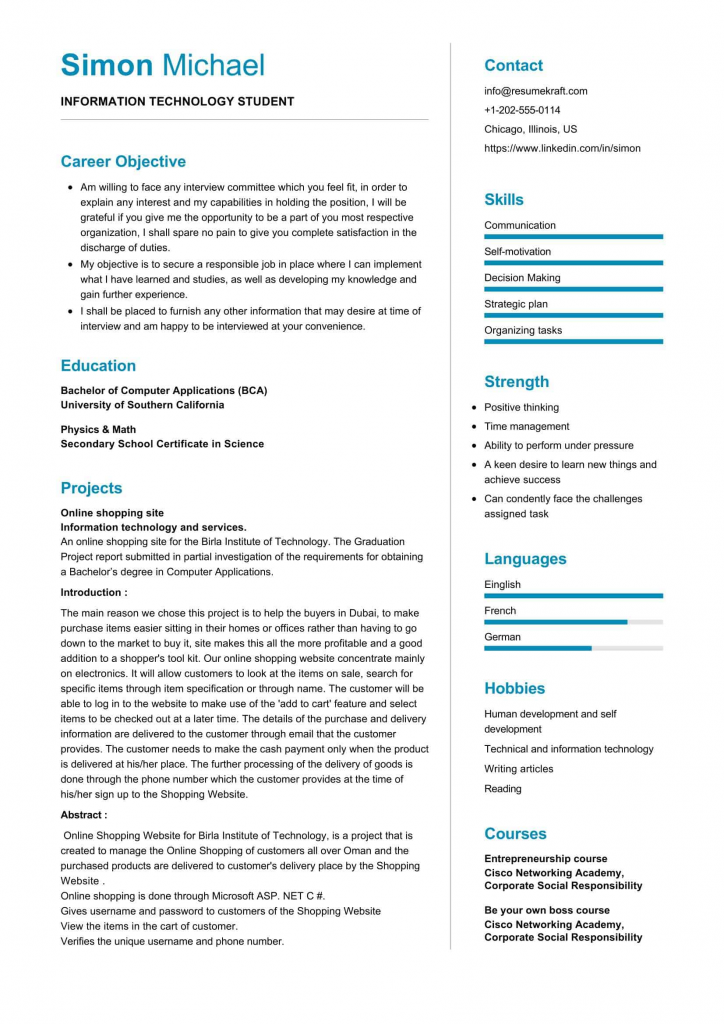
Finance Graduate Resume Sample
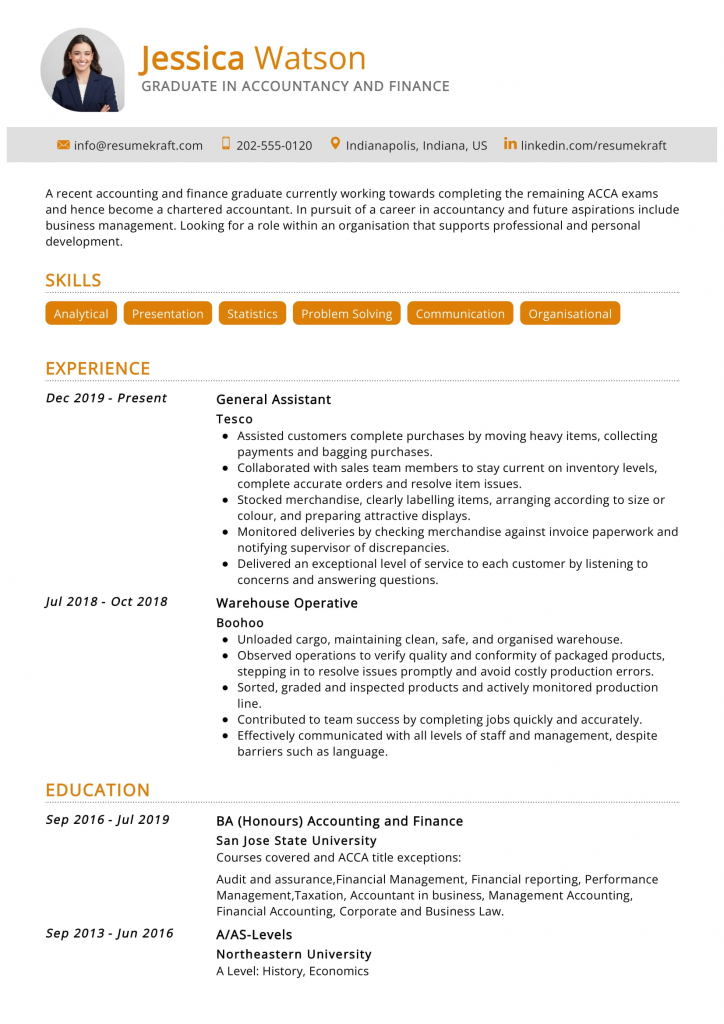
Accounting Information Systems Graduate Resume
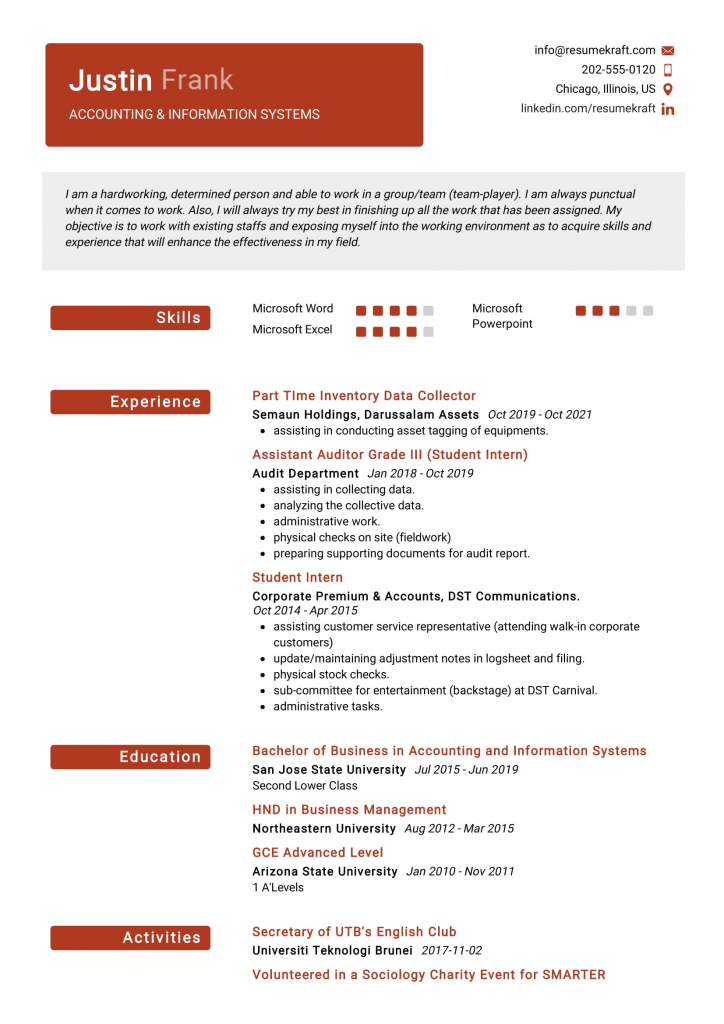
Business Management Graduate Resume Sample
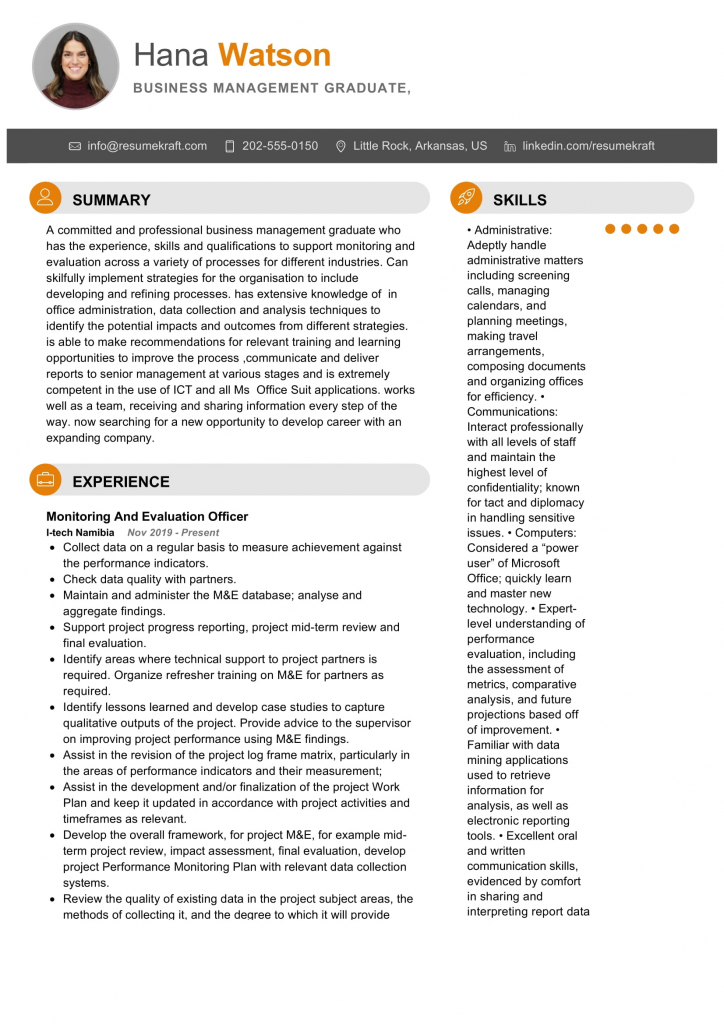
Business Graduate Resume Sample
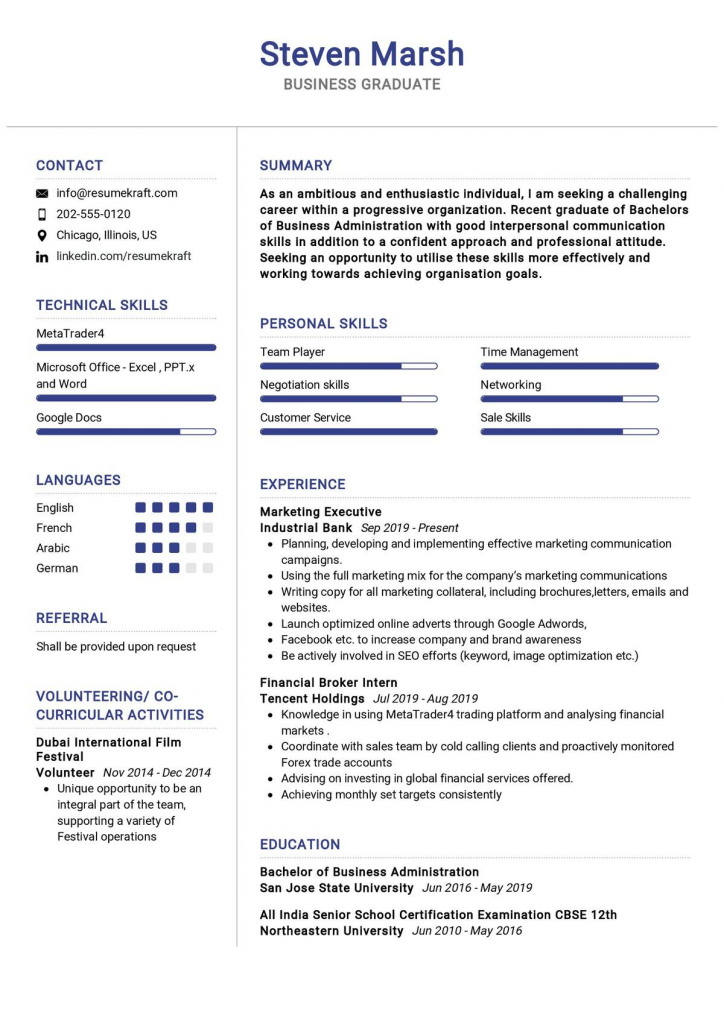
Final year Graduate Resume Sample
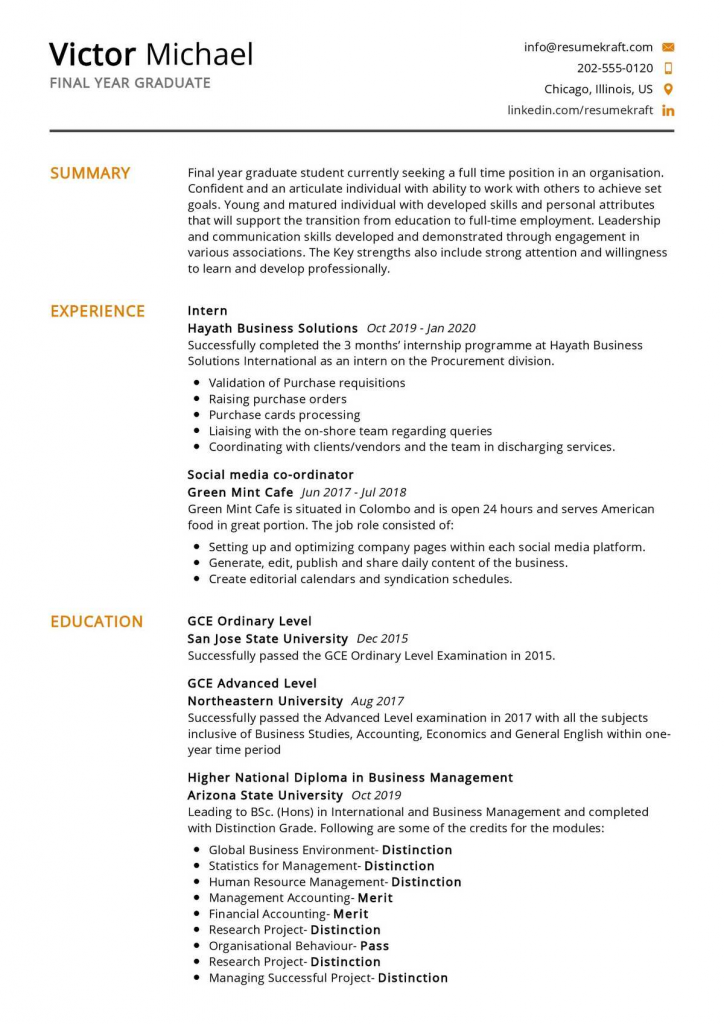
Fresh Graduate Resume Sample
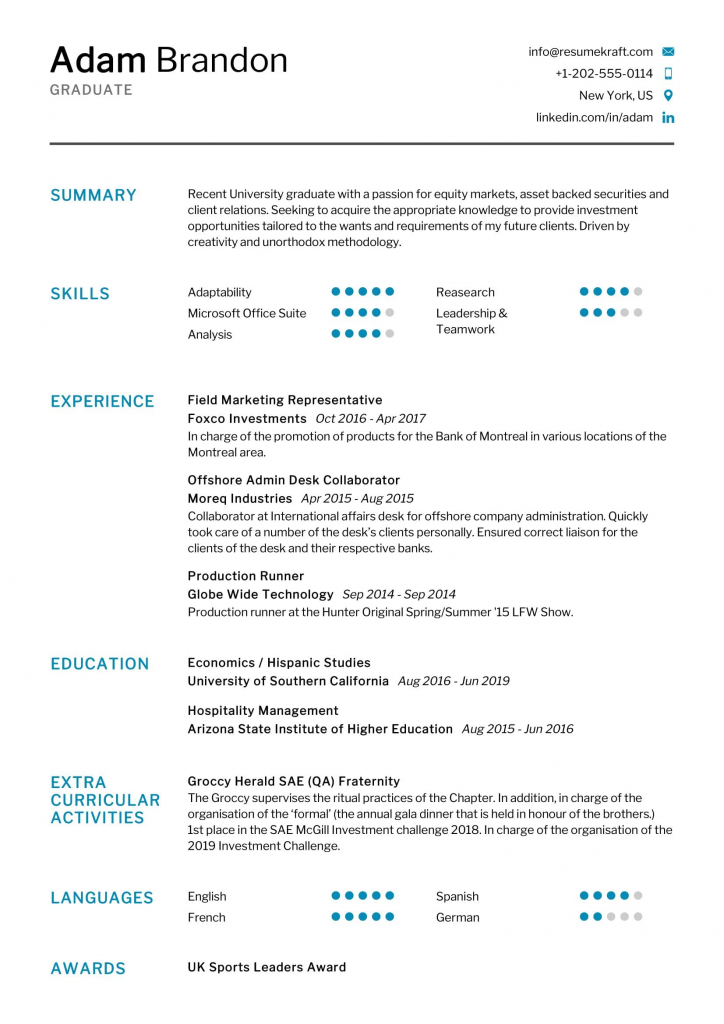
Graduate Student Resume Sample
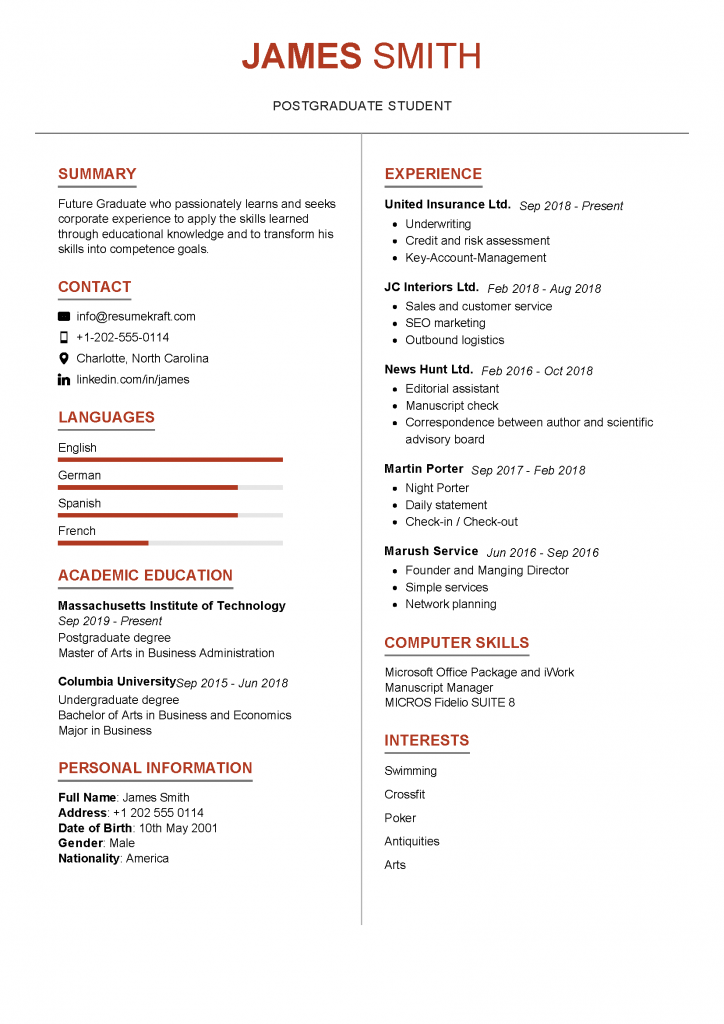
Frequently Asked Questions
A college graduate should include their education, relevant coursework, internships, part-time jobs, volunteer work, skills, and any certifications or awards on their resume. They should also include a compelling objective or summary at the beginning.
Writing a new graduate resume involves highlighting your education, showcasing any relevant experience (including internships and part-time jobs), listing your skills, and adding additional sections like certifications or volunteer work. It’s also important to tailor your resume to each job you apply for.
A graduate resume is a document that a recent college graduate uses to showcase their education, skills, and experience to potential employers. It’s typically used to apply for entry-level positions.
When writing your first resume after college, start by choosing the right format. Then, include a compelling objective or summary, highlight your education and any relevant experience, list your skills, and consider adding additional sections like certifications or volunteer work.
If you’re a graduate with no experience, focus on your education, relevant coursework, skills, and any extracurricular activities or internships that have given you relevant experience. You can also include volunteer work, certifications, and hobbies that demonstrate transferable skills.
To make a fresher resume, start with a compelling objective that highlights your career goals and relevant skills. Then, include your education, any internships or part-time jobs, your skills, and any additional sections like certifications or volunteer work.
The chronological resume format is often recommended for fresh graduates. This format is easy to read and allows you to highlight your education and any internships or part-time jobs you’ve had.
Yes, a one-page resume is typically sufficient for freshers. As a recent graduate, it’s important to keep your resume concise and focused on your education, skills, and any relevant experience.
Yes, freshers need a resume to apply for jobs. Even without much professional experience, a resume allows freshers to showcase their education, skills, and any internships or part-time jobs they’ve had.
Conclusion
Stepping into the professional world as a recent college graduate can be a thrilling journey. Your resume is a critical tool that can open doors to exciting opportunities. By crafting a compelling objective or summary, highlighting your education and relevant experience, listing your key skills, and adding additional sections that showcase your unique qualifications, you can create a resume that stands out from the crowd.
Remember, your resume is more than just a list of your qualifications. It’s a reflection of you as a professional. Make sure it accurately represents your skills, experiences, and ambitions. And don’t forget to pair it with a well-crafted cover letter that complements your resume and further tells your story.
With a strong resume in hand, you’re ready to embark on your professional journey. Good luck!

